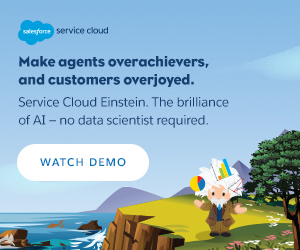This content was produced for Salesforce by the foundry @ MEREDITH CORP. FORTUNETM editorial staff was not involved in its creation or production.
For companies large and small, digital transformation can seem intimidating. They’ve heard the mantra—every business today is a digital business. They know they must evolve to compete, but they get frozen in their tracks. Major firms look at their legacy technology, worry that an overhaul will be costly and that day-to-day business will stall as staff navigates the learning curve that they imagine comes with new tools. More modest enterprises, meanwhile, may feel overwhelmed by choices, decisions, and first steps: Where to begin?
With new disruptors emerging every day, however, the fact is no firm has time to waste. The digital world that seamlessly connects customers on a myriad of devices to every aspect of the marketplace, including service, has been a fundamental game changer. If you aren’t playing by the new rules, you automatically lose.
Let’s address the fear factor off the top. Cost? You can scale up at the right pace, assessing your ROI at each stage along the journey. Legacy equipment? As-needed cloud services integrate effortlessly with your current systems. Downtime? New tools are so intuitive, they’ll up your team’s productivity from the get-go.
As for where to begin: We recommend starting with the very hub of your enterprise—the contact center.
Why start there? A contact center is where your customers tell you what’s on their minds. If you’re listening to them carefully on every channel, you can take measure of their observations, desires, and influences. And you can use that intelligence to stay ahead of the curve by shaping the future success of your company based on their needs. That’s a lot of bang for the buck.
For some traditional enterprises, though, this calls for a mental reset. Many are used to thinking of the contact center as a cost center. But if you start looking at it as a profit center, the shift in perspective is telling—and investing in it begins to make sense.
“The call center gets marginalized on a regular basis. It’s thought of as a necessary department and cost structure required to deal with unhappy customers and to put out fires,” says customer-experience consultant Jeanne Bliss. “It’s not viewed as an indicator of the early issues that can help drive the business. [But] the call center doesn’t just take the call and build the bond; it can take hold of the information and report on things in a much more strategic way.”
What’s more, a contact center is a lab in which to incubate a transformation that can spread companywide by providing a real-time feedback loop that facilitates gradual change and investment in new technology.
 Photo: Getty Images
Photo: Getty Images
Working collaboratively, your IT department and your contact center leaders can boost one another’s performance exponentially. Together, they can start breaking down silos—a move that can go viral throughout your organization. How? They can help your firm evolve from a multichannel universe—one in which social media platforms can’t share insights with email hubs, for example—into an omnichannel one that collects and synthesizes information from every available source and prepares it for analysis in the C-suite.
In this scenario, contact centers become the crucial link between your company’s front and back offices, providing a steady flow of intelligence that informs C-suite planning and stratagems as well as traditional customer-facing services. In short, contact centers are the beating heart of the enterprise, pumping lifeblood into every aspect of your organization.
So what does all this mean in the context of the digital transformation journey of the contact center? Think of the exercise as twofold—equal parts iteration and innovation. The dictionary defines iteration as a procedure in which repetition of a sequence of operations yields results successively closer to a desired result. As far as digital transformation goes, iteration means integrating new technologies as well as bringing existing processes and policies up to speed—at scale—to deliver better products and services. For its part, innovation involves integrating new technologies too, but it stresses the long game. It’s about reimagining processes, policies, and systems with a view to creating new value. State-of-the-art contact centers succeed because they are both iterative and innovative.
If we leave you with one takeaway, it should be this: Your contact center is not a cost center. It’s the place where digital transformation starts. It’s the site where deep insights are buried, waiting to be unearthed, as long as you have the right tools to mine them. It’s where value can be created and business strategies can form. In other words, it’s a full-fledged—and often leading—partner in your enterprise. Are you treating it accordingly?







